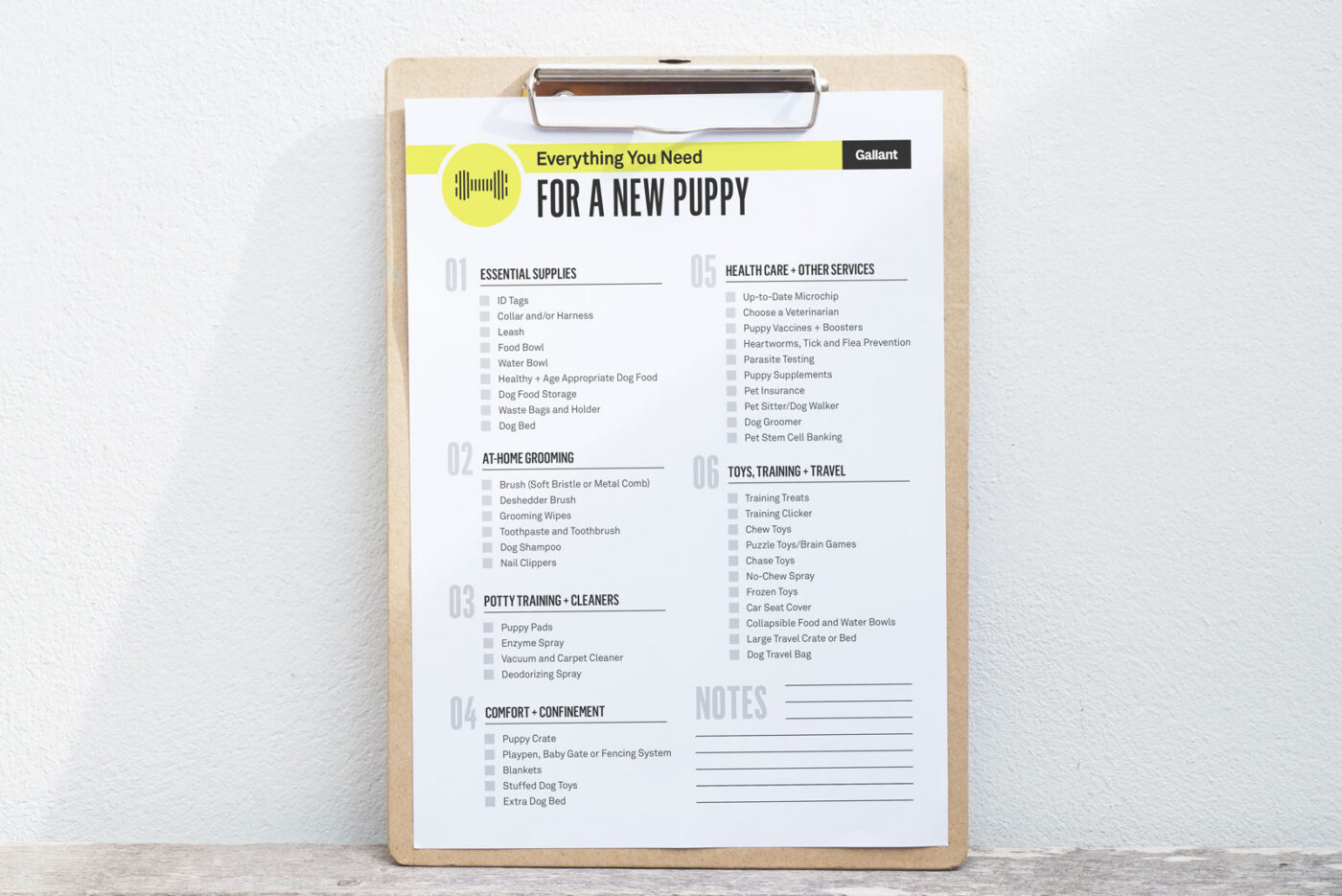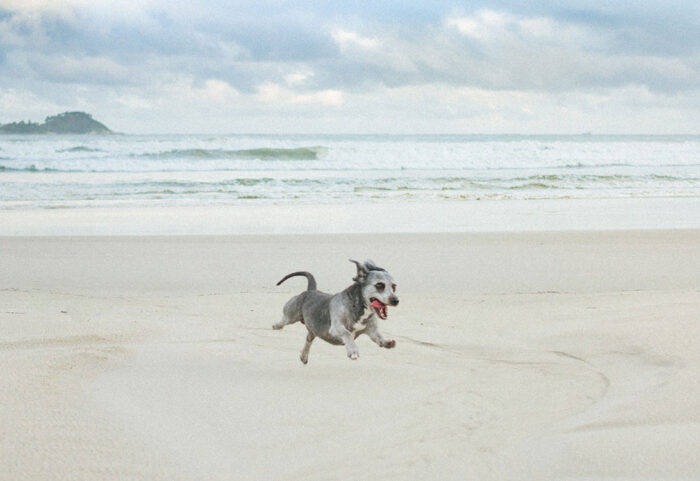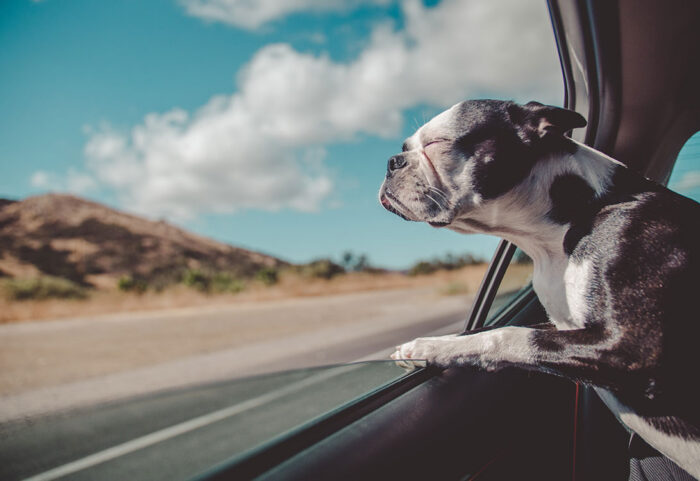The New Puppy Checklist You’ve Been Searching For
Puppies — they’re cuddly, playful and cute. They grow up to be your best friend and closest companion. They’re also A LOT of work.
If you’re prepared, you can avoid a lot of the speedbumps many new puppy owners run into. You’ll need to get your new pup set up with a veterinarian, start housebreaking and have a plan to spend a good amount of time home with them (in the beginning).
You’ll also need to buy some supplies. Toys, food and a collar are just the beginning — there is a whole slew of things you can get to make your life easier with a new puppy. Here we’ll cover them all. Also, check out our printable new puppy checklist!
We’ll start with the supplies that are essential to successfully raise a puppy. We’ll also cover essential health care you’ll need to provide for your dog. After that, most of the supplies listed are optional. However, we’d recommend purchasing as many as possible for a smooth transition into life with your new best friend.
Essential Supplies
Health Care and Other Services
Grooming
Puppy Comfort and Confinement
Potty Training Supplies and Cleaners
Toys, Training and Travel
Puppy Proofing
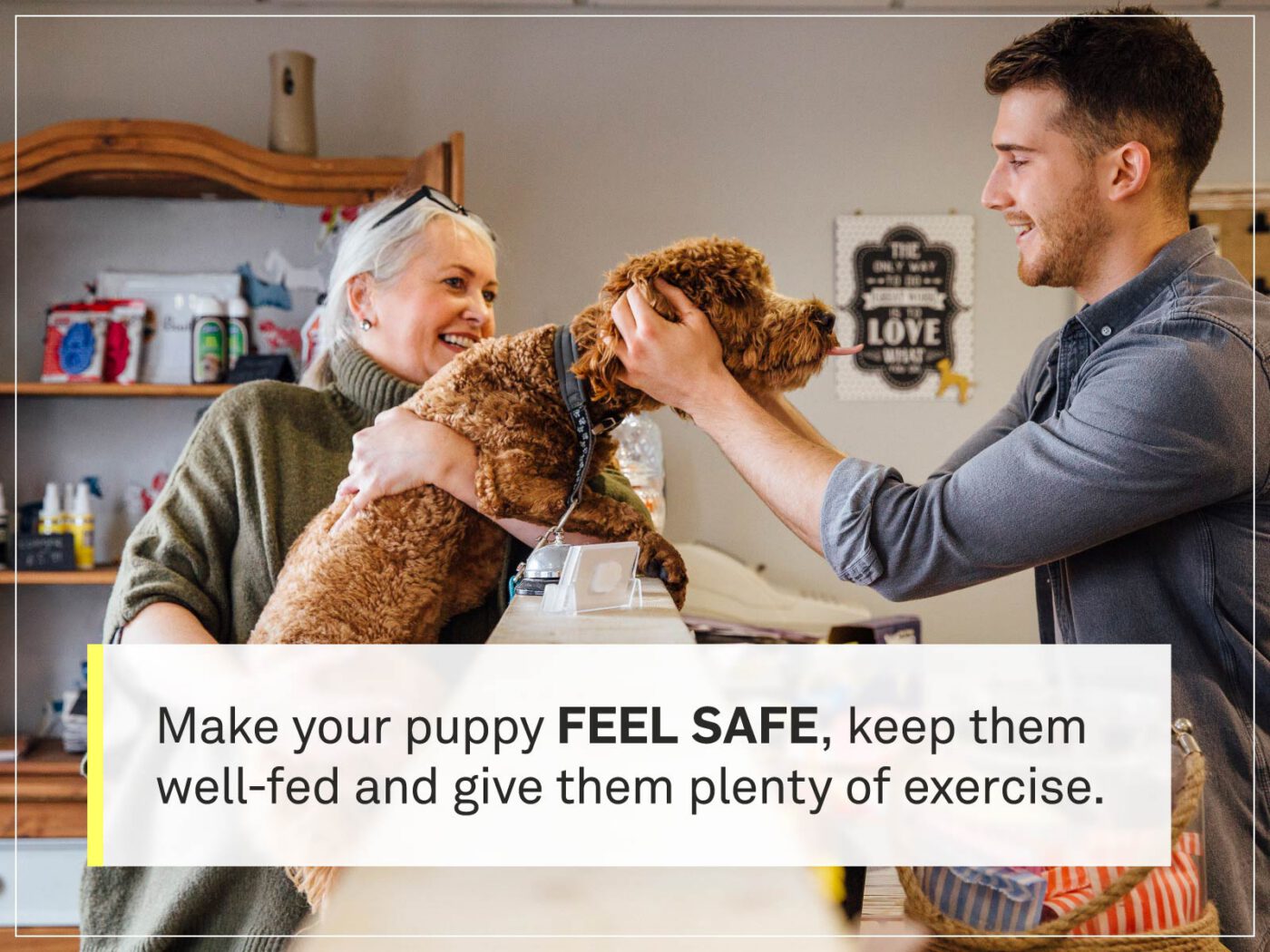
Essential Supplies
These supplies are the bare bones puppy supplies. It would be smart to purchase every item in this section so that you have everything to make your puppy feel safe, keep them well-fed and give them plenty of exercise.
ID Tags
The ID tag you buy will go on your pet’s collar. This is very important so that if your pup happens to get lost, the person who finds them will know how to get them home safely to you. Information to put on your tag should include your name, phone number and address.
Collar and/or Harness
Get your puppy a collar or harness so that you can take them on walks, hold on to them if you need to and have a place to hang their tag. We recommend a breakaway collar (one that automatically snaps off if enough pressure is applied) to prevent any sort of accidental choking.
A martingale collar can be used for leash training once the puppy gets a bit older, but we wouldn’t recommend getting a choke collar or any other device that harms your pup for training purposes.
Leash
The best leash to get your puppy is a fixed-length, “straight” leash. They come in a variety of fabrics, widths and lengths and most feature a loop at the end for you to grip. When choosing a leash consider the size of your dog so that you can choose the weight of your leash (thicker for larger dogs, thinner for smaller).
Food Bowl
There are many types of food bowls that offer different features. Some are plastic, others are metal. There are even more that are elevated or automatic — consider your dog’s size and your budget to choose. You will also want to consider safety, style, durability and ease of cleaning.
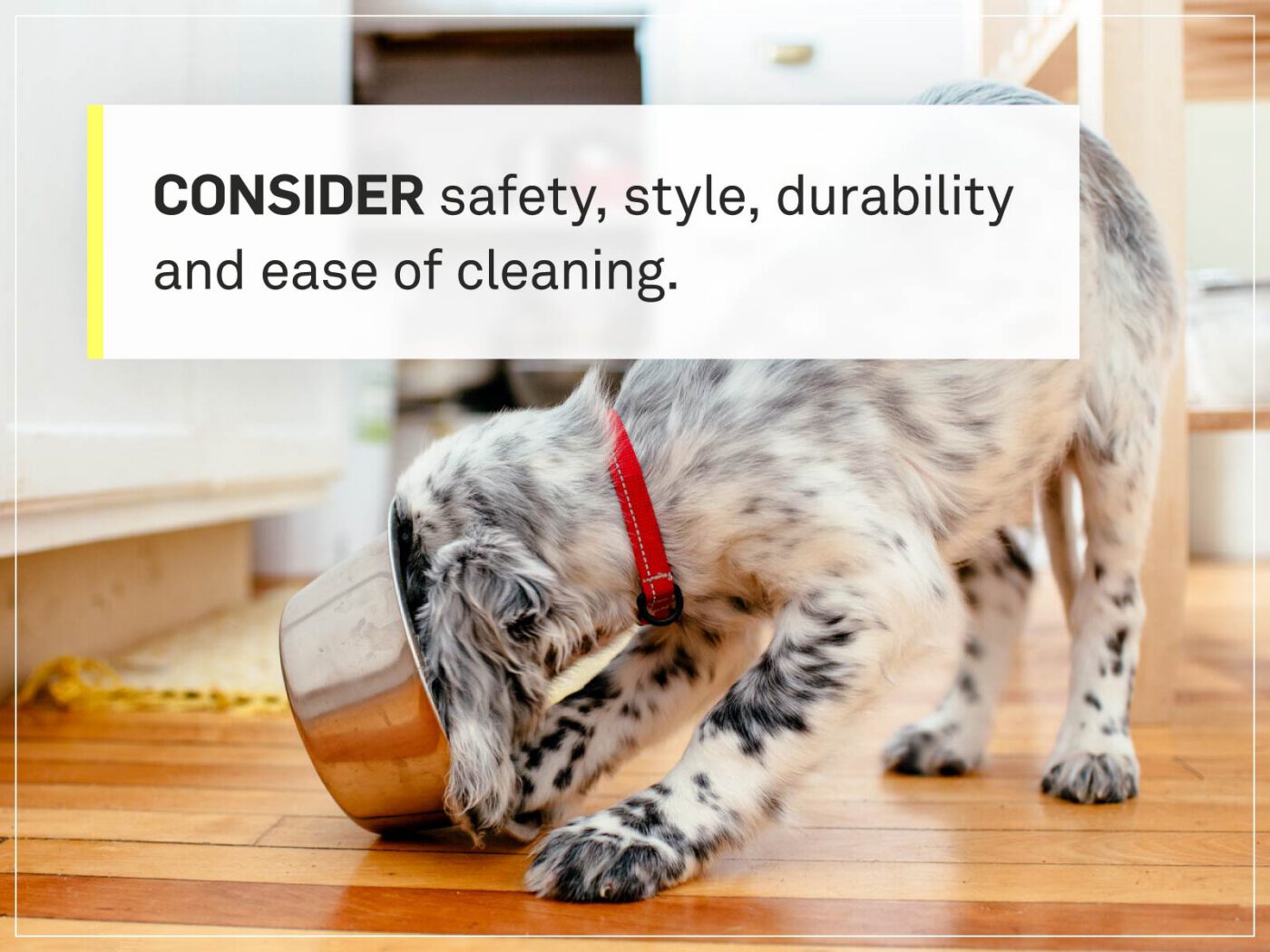
Water Bowl
Just like with a food bowl, you’ll want to think about which water bowl will be best for your specific situation. If your dog tends to be clumsy, a plastic bowl will work better than ceramic. If your dog likes to chew, a metal one might be better than plastic. Sometimes you can find matching food and water bowls to purchase together!
Healthy + Age Appropriate Dog Food
Dogs aren’t strict carnivores — meat makes up the majority of their diet, but they also benefit from the addition of grains, fruits and vegetables in their dog food. To ensure they’re getting all the vitamins and minerals that they need, choose a food that contains all three.
The best dog foods contain high-quality meats, vegetables, grains and fruits. Meat should be the primary ingredient. Since your puppy’s nutritional needs are different during the first year of their life, choose a puppy formula or one that is designated “for all life stages.”
Dog Food Storage
Dry dog food can become stale if it’s stored only in the original bag. To ensure your pup’s food is always tasty, invest in a dog food storage container. Airtight is best to make sure their food stays fresh.
Waste Bags and Holder
No matter where you live you will need dog doo-doo bags and something to hold them in. You can purchase very compact dog waste holders that attach to your leash or dog bag. If you have a yard, invest in a pooper-scooper to help you more easily clean up after your dog.
Dog Bed
A dog bed is a must to make sure your pup feels safe and comfortable in their new home. They sell a variety of dog beds at many different price points, although we would recommend getting one on the lower end of the spectrum at first.
At first, your pup may not know that they are not allowed to soil their beds, so be sure to get one that is washable. Be prepared for the possibility that they may rip their bed up as well.
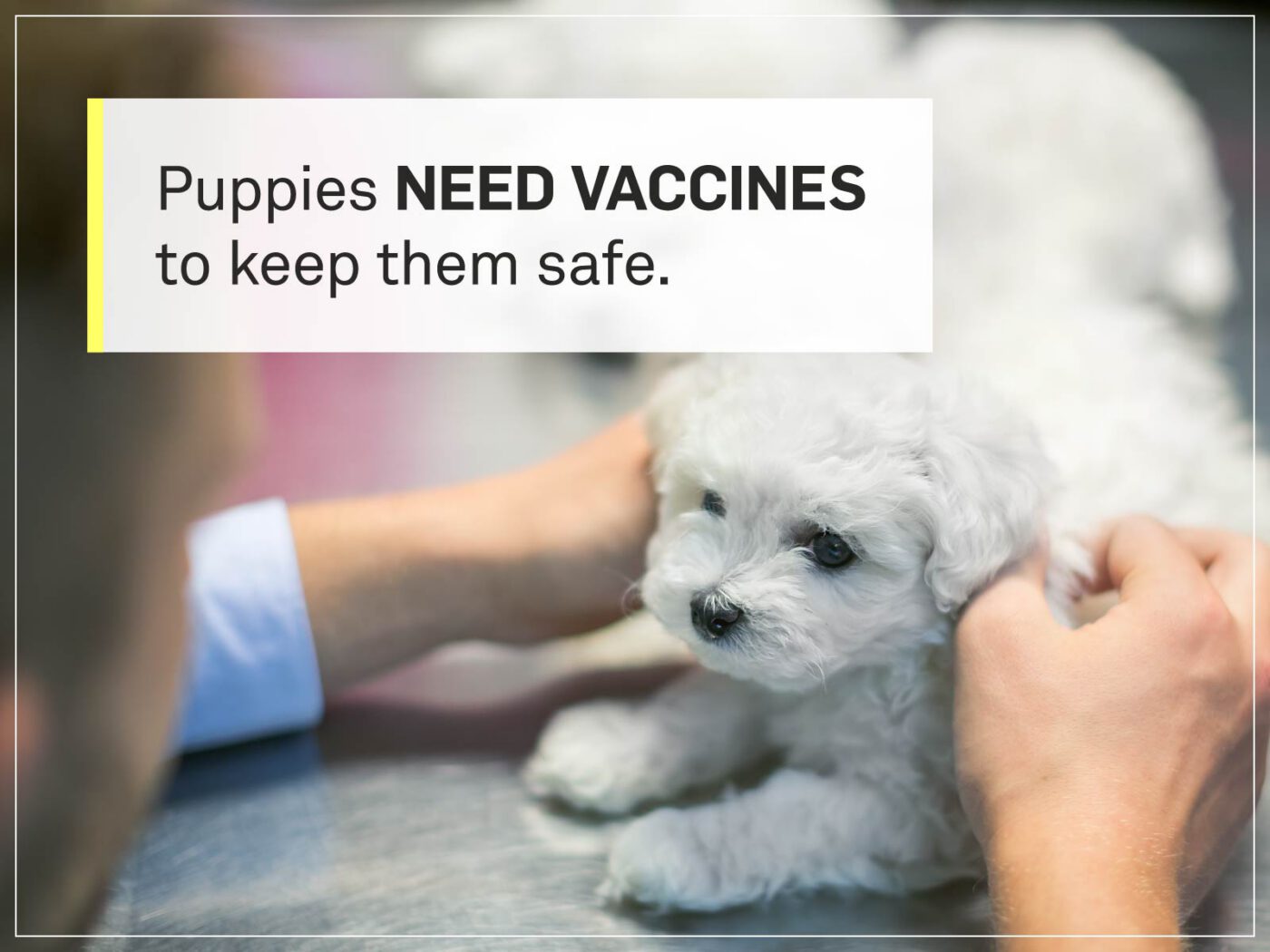
Puppy Health Care and Other Services
When it comes to your new puppy’s health there are several things you will need to accomplish right off the bat. Puppy’s need a good amount of vaccines to keep them safe and they will need to get on preventive medicine for heartworms, fleas and ticks. Never fear —we’ll cover the specifics below!
Up-to-Date Microchip
It’s very important to ensure your puppy has a microchip inserted beneath their skin. A microchip is a small implant about the size of a large grain of rice. This chip stores your contact information inside of it and can be read by a veterinarian or shelter. This is an important backup in case your dog gets lost without their collar on.
Choose a Veterinarian
Much like you would a human doctor, it’s best to choose one veterinarian that your dog will see throughout their life. This will help them feel comfortable and also ensure that your pet’s doctor knows their full health history.
We recommend choosing one that is close to where you live and one where your dog feels familiar and at ease. There are low-cost clinics for those who require discounted services, but because they don’t provide the gold standard of care, we’d suggest going to your trusted vet.
Puppy Vaccines + Boosters
Puppies need a slew of vaccines their first year including their bordetella bronchieseptica, canine distemper, canine hepatitis, canine influenza, coronavirus and leptospirosis vaccines. They will also need a vaccine against Lyme disease, parvovirus and rabies.
This vaccination schedule starts between 6-8 weeks of age and continues throughout your dog’s life. You can find a full schedule here. Getting your puppy all of the necessary vaccines and boosters is absolutely essential.
Heartworm, Tick and Flea Prevention
Another essential part of puppy healthcare is getting them on heartworm protection. During their first year of life you will need to give them a pill every month (some include flea and tick prevention). After they are one year old your dog can replace the pill with a bi-annual shot if you choose.
If your heartworm medication doesn’t contain it, it’s smart to get them flea and tick prevention so that they never attract the parasites (or bring them into your home).
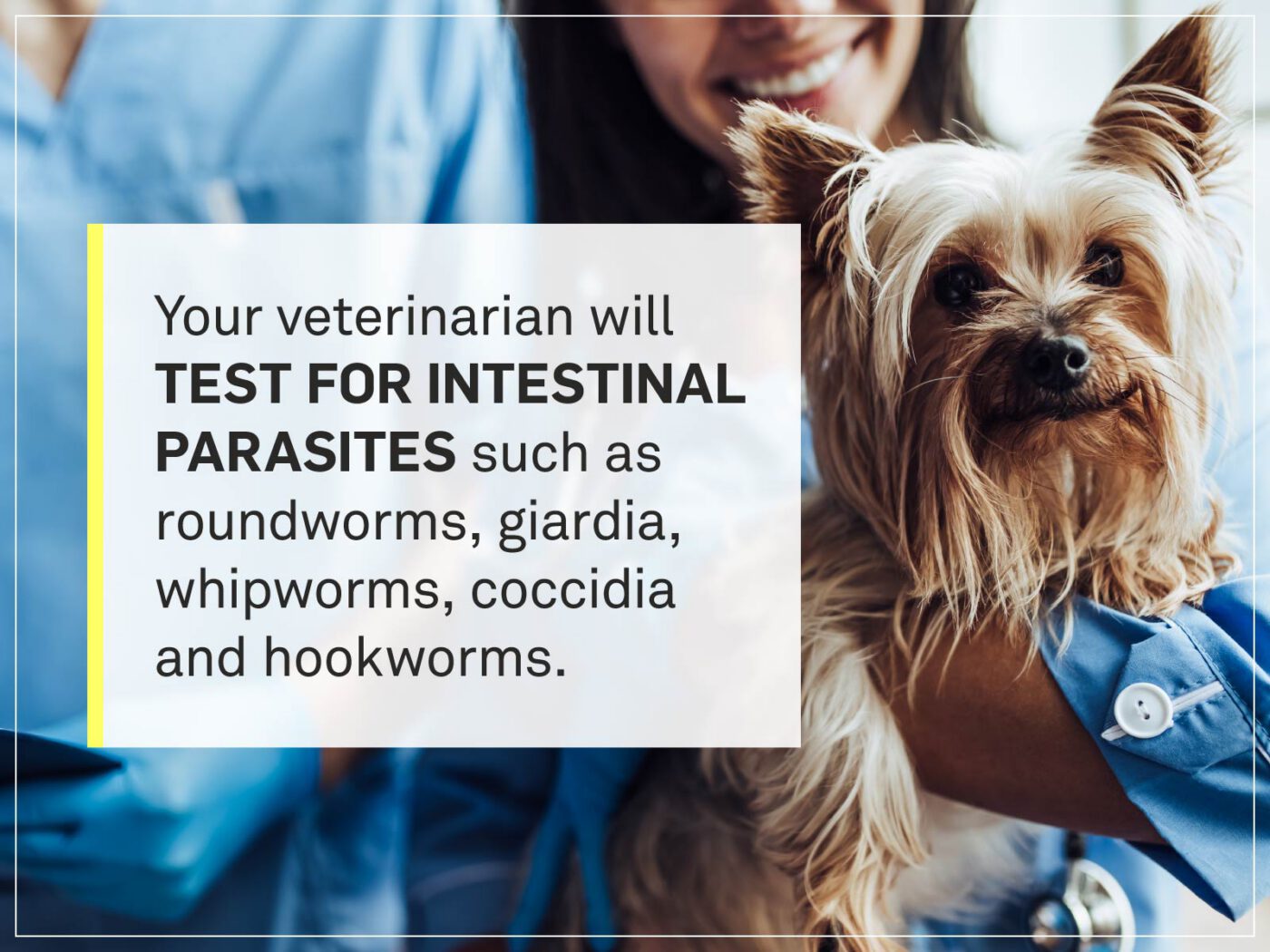
Parasite Testing
Your veterinarian will want to test your dog for intestinal parasites such as roundworms, hookworms, whipworms, coccidia and giardia. They do this by collecting stool samples and testing them in a lab.
These pets will be tested as puppies to ensure they didn’t pick up anything before you adopted them and will need to be tested yearly thereafter.
Puppy Supplements
While not a necessity, many people find that giving their puppy supplements helps build their bones, bodies and brains. You can find supplements containing protein, fatty acids, minerals and digestive aids. Many puppy foods also contain these, so make sure you read your labels!
Pet Insurance
Also not mandatory, but many pet owners find that pet insurance helps them cover the cost of healthcare for their pup. Most insurance providers begin coverage at 6 weeks of age and there is a wide variety of plans available. Depending on the plan, pet insurance can cover accidents and illnesses, routine care, breed-specific conditions and even behavioral therapy!
Pet Sitter/Dog Walker
If you work long hours, live in an apartment or would just like some help taking care of your new friend, consider hiring a pet sitter or dog walker. You can use sites like Rover to help you find one at an affordable cost in most cities.
Make sure you do your research, read multiple reviews and thoroughly interview your dog walker first. Treat it as if you were hiring a babysitter for a human child. You wouldn’t want to put your puppy into the wrong hands!
Dog Groomer
If you have a long-haired dog or one that requires a bit of primping, look into a reliable dog groomer. If you can, take your dog to the same groomer throughout their life. Much like with a veterinarian, you will want your dog familiar with their groomer so that they are comfortable and feel safe.
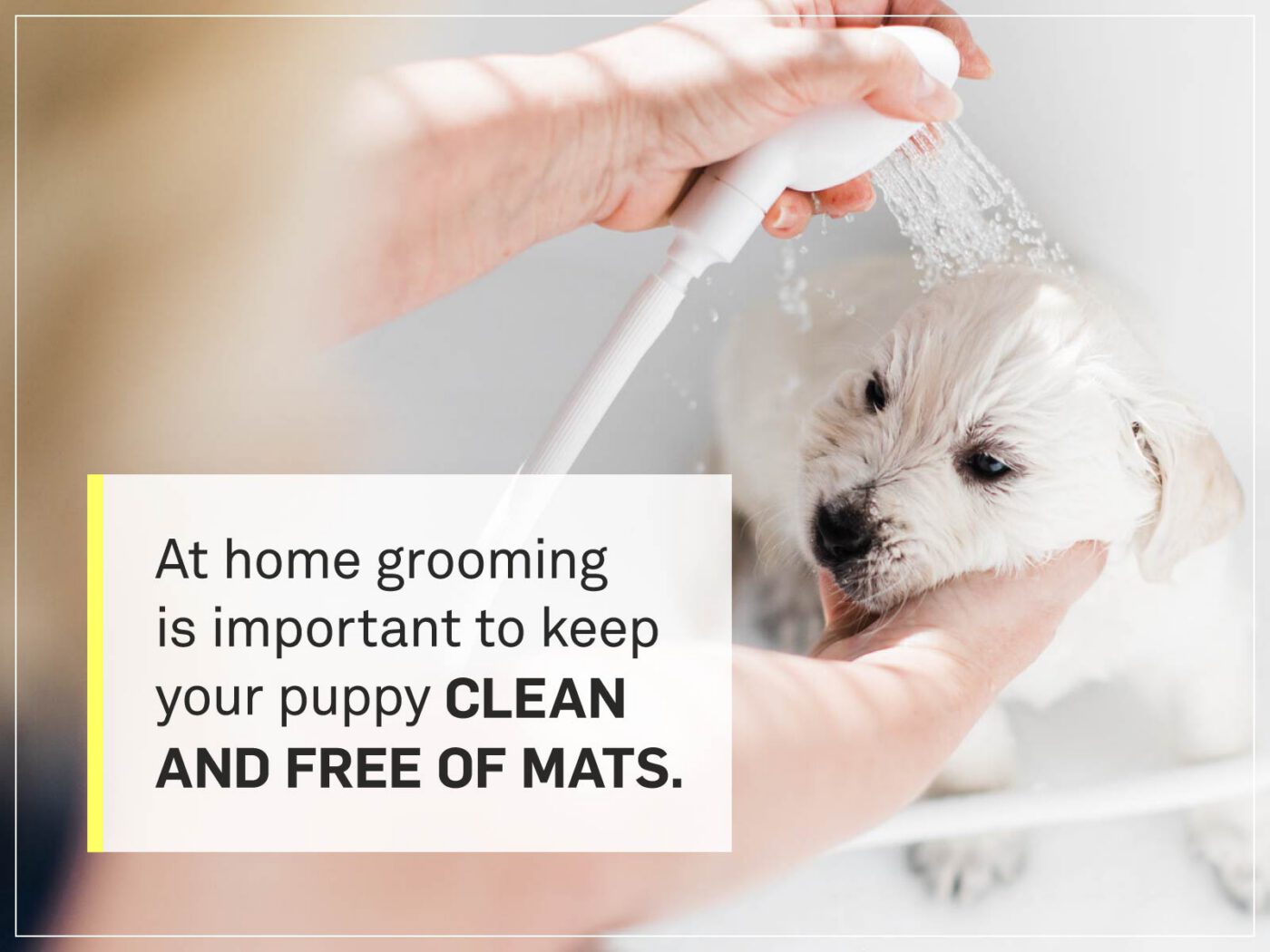
Puppy Grooming
Even if you have a groomer that you frequent, you will want to purchase some puppy grooming materials for in-between visits. Most of these are optional, depending on how hands-on you want to be.
Brush (Soft Bristle or Metal Comb)
Most pets will require a weekly brush to make sure their coats stay soft and healthy. If you have a long-haired dog you may need to brush them out more often than that. A soft bristle or metal comb brush will work for most breeds.
Deshedder Brush
If you have a dog that sheds quite a bit you might want to consider getting a deshedder brush. These are brushes that you can use to eliminate some of the dog’s hair which may not be removed with regular brushing or combing.
Grooming Wipes
Pet stores sell special grooming wipes for dogs that you can use in between baths to keep them fresh and clean. These are also particularly helpful for dogs who have eye discharge, as you will want to remove them daily with these wipes. If you ignore eye discharge it can cause uncomfortable hair matting in long-haired breeds.
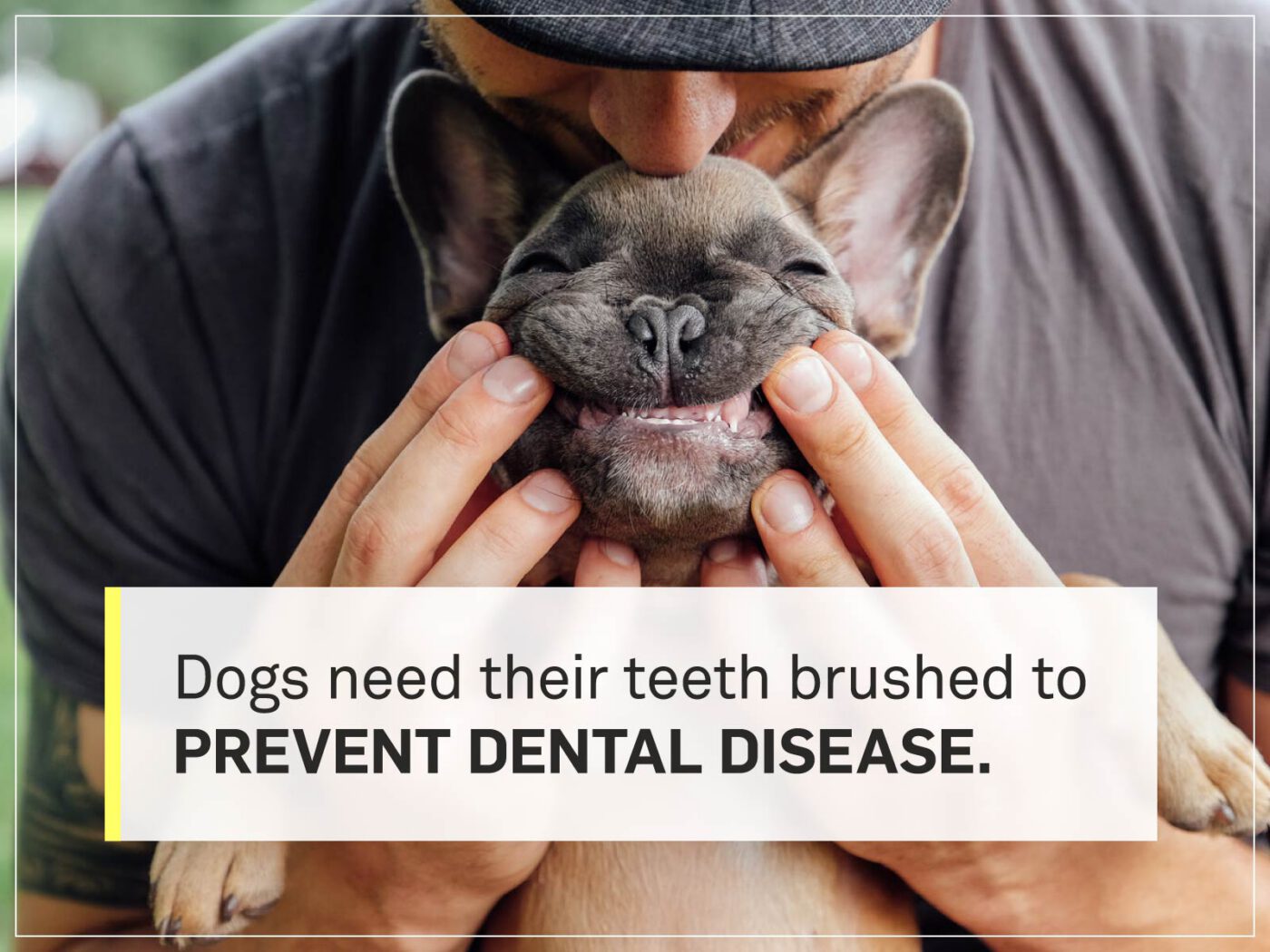
Toothpaste and Toothbrush
Dogs need their teeth brushed just like humans. To prevent dental disease, it’s recommended to brush your dog’s teeth at home as often as you can — one to three times a week is best. It’s important to get your dog trained on tooth brushing early so that you can continue to do it throughout their life without any issue.
Dog Shampoo
If you want to give your pup a bath in-between visits to the groomer (or if you want to manage the grooming yourself) you will need a dog-specific shampoo. These shampoos are tear-free and formulated especially for your dog’s coat. If their skin is irritated, try an oatmeal shampoo!
Nail Clippers
Clipping your dog’s nails at home can be risky if you don’t know what you’re doing. However, many dog parents learn how to do so successfully. If you plan on learning how, get yourself a pair of dog nail clippers. Some have safeguards to ensure you don’t cut into their quick.
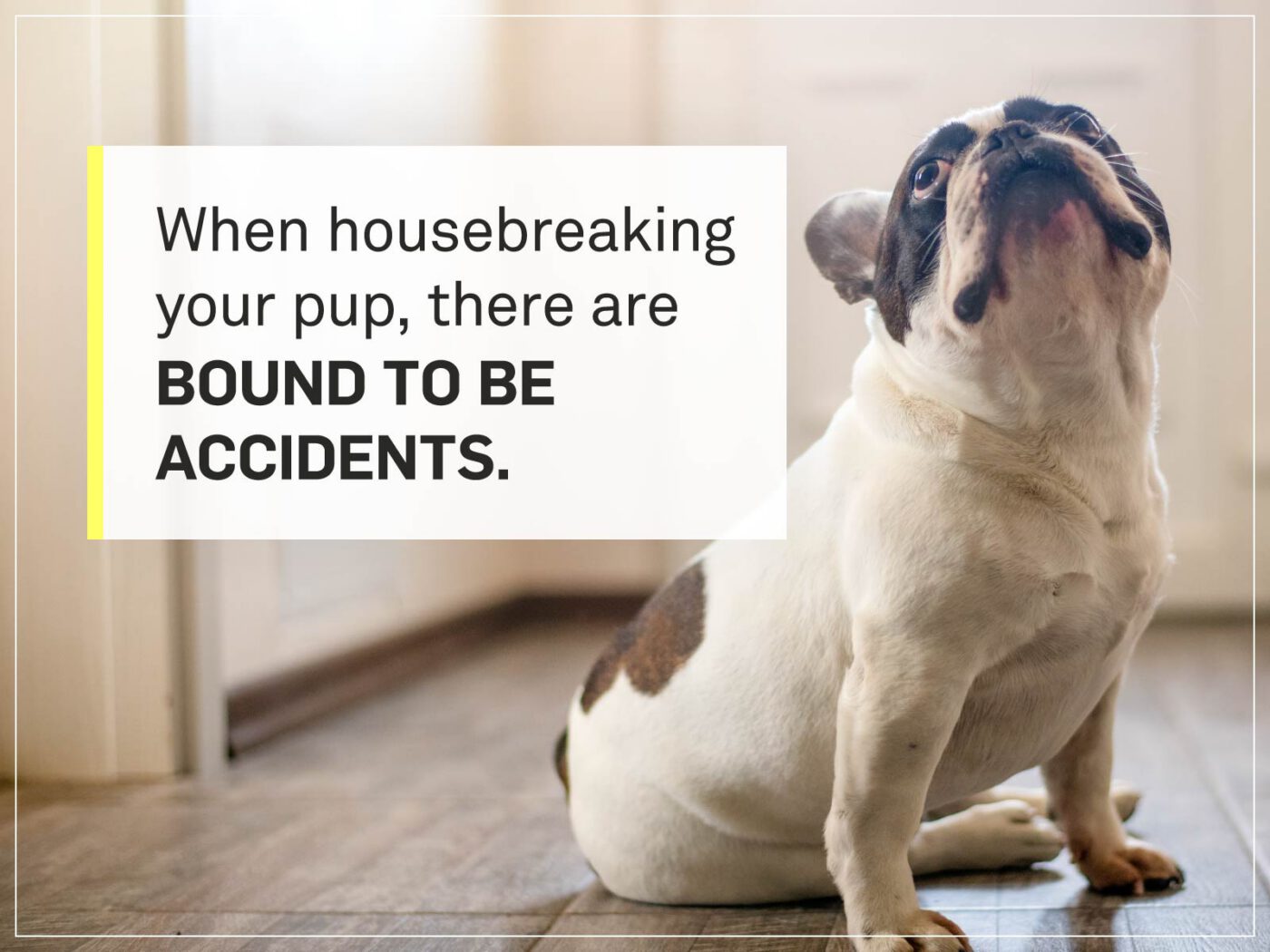
Potty Training Supplies + Cleaners
Teaching your dog to relieve themselves outdoors is a large part of puppy training. It can be frustrating, at times, and there are bound to be accidents. Luckily, there are all sorts of products to help ease the process along.
Puppy Pads
These are pads you can place on your floor and train your pup to pee on them if they can’t make it outside (or if they need to go during the night). They make cleanup a lot easier and are a great tool to have on hand when potty training.
Enzyme Spray
If your dog does happen to have an accident on the floor, spray it with enzyme spray. This special spray helps break down the natural starches, oils, fats and other proteins so that clean up is a breeze. It also helps with odor control!
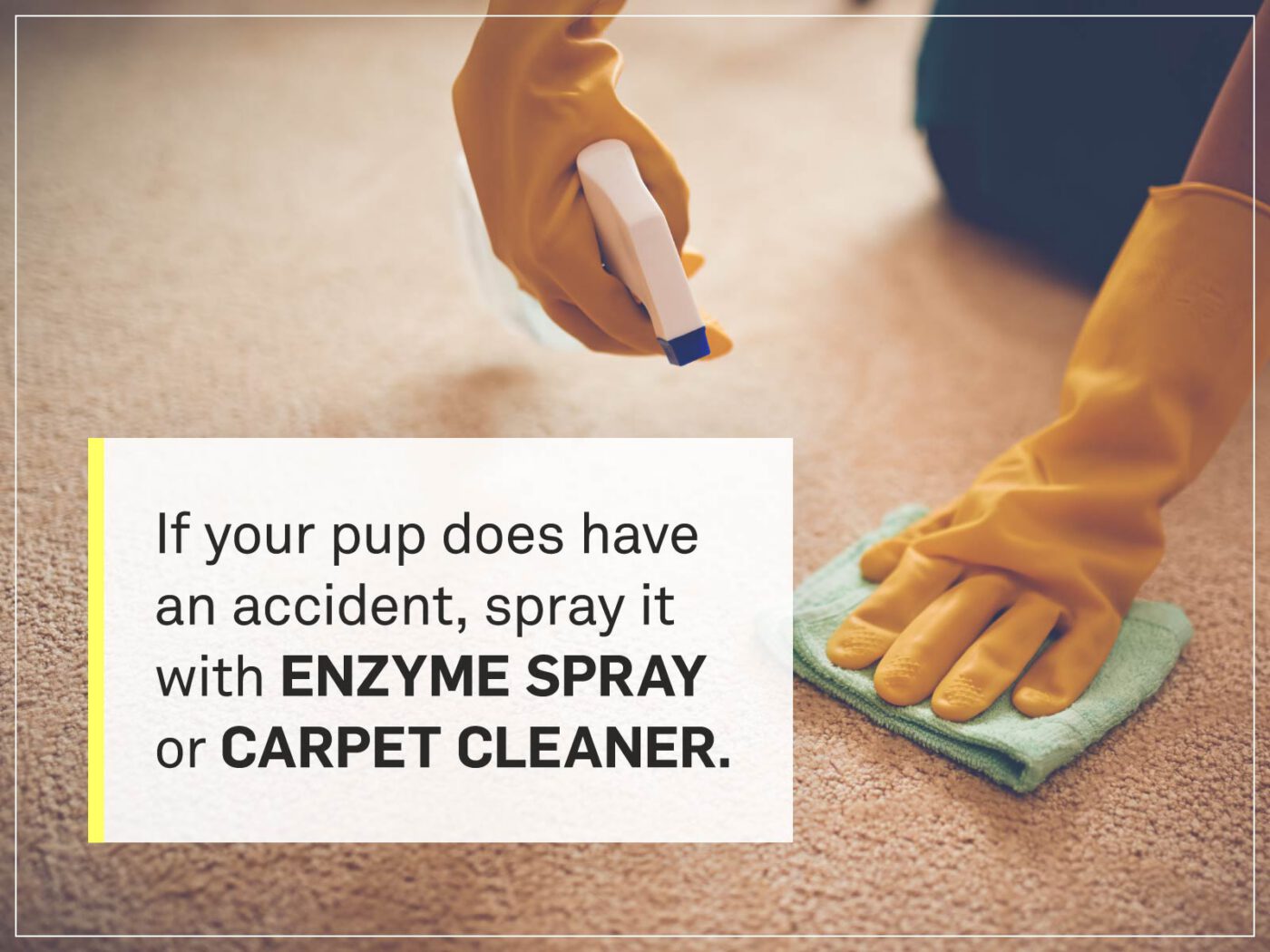
Vacuum and Carpet Cleaner
If you have a pup, you will likely need a vacuum. Most dogs shed which can lead to unwanted piles of hair lying around the house.
While your pet is potty training you will also need a carpet cleaner just in case an accident happens on the carpet. It’s helpful to have this on hand after puppyhood as well in case they track mud or anything else onto the carpet.
Deodorizing Spray
Puppies are cute, but they can also be smelly. Keep a deodorizing spray on hand to spray any pillows, blankets, couches or carpets that inevitably pick up their scent. This can be handy to spray around the house, but avoid spraying your pup directly.
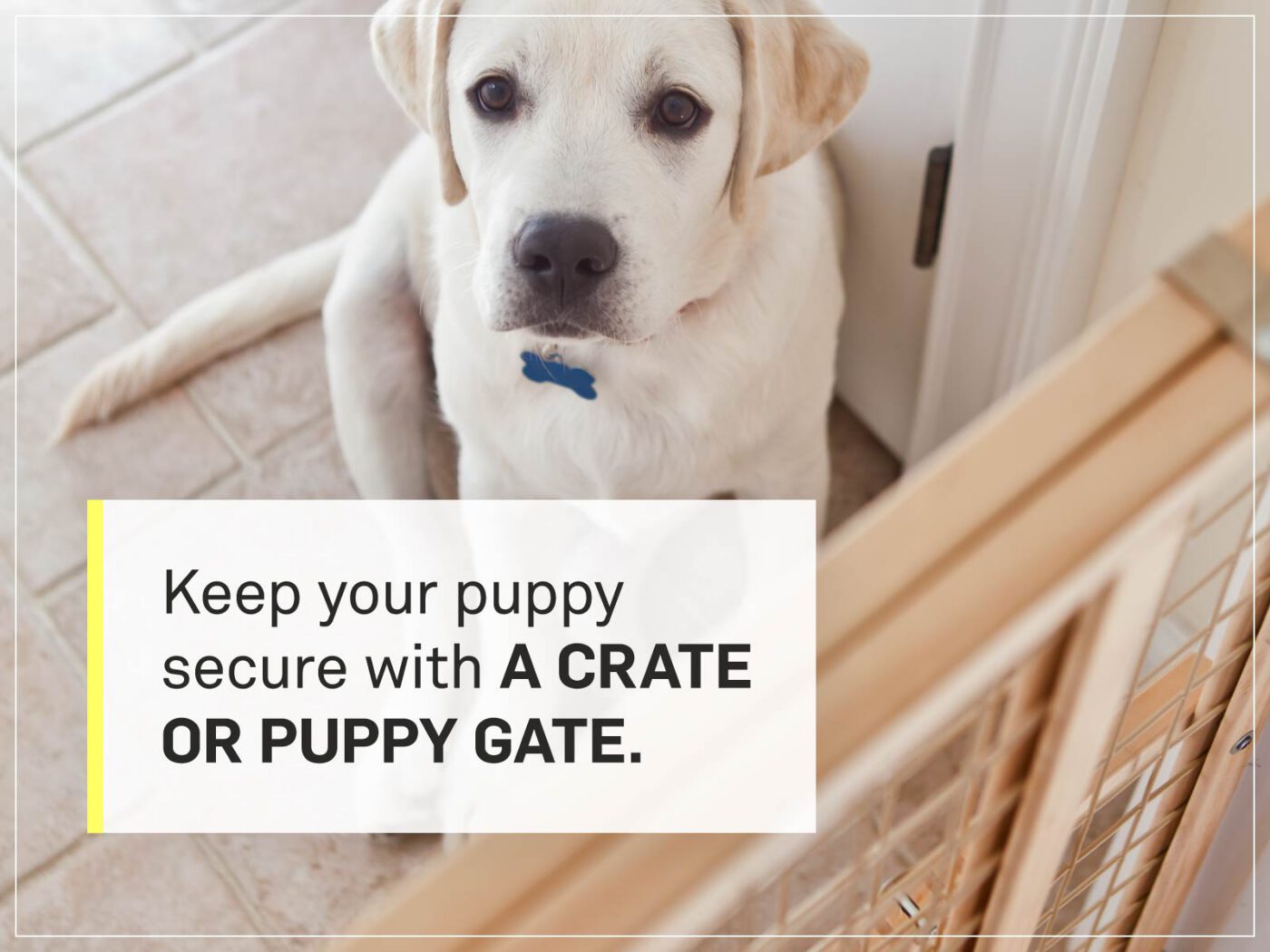
Puppy Comfort and Confinement
It’s important to make sure your puppy is secure and comfortable in your home. In order to do this, you may need to keep them confined to areas that are safe. While in confinement (and outside of it) it can be helpful to have comforting, soft things for your pup to snuggle with.
Puppy Crate
Many pet parents will choose to “crate” or kennel their puppy at night and when they are gone. Crate training can help with potty training and give your pet a safe place to retreat to when they get ready for bed.
Kenneling can also help mitigate chewing and destruction of your possessions while you are gone. Be sure you introduce your pup to their crate the right way, though, or your puppy may become scared or anxious when crated. Never, ever use the crate as punishment or leave your puppy in the crate for more than a few hours.
Playpen, Baby Gate or Fencing System
You may have areas of the home that you don’t want your puppy going, for instance, your office that is full of wires or your human child’s room. You can buy a baby gate, fencing system or even a doggy playpen to keep your puppy confined.
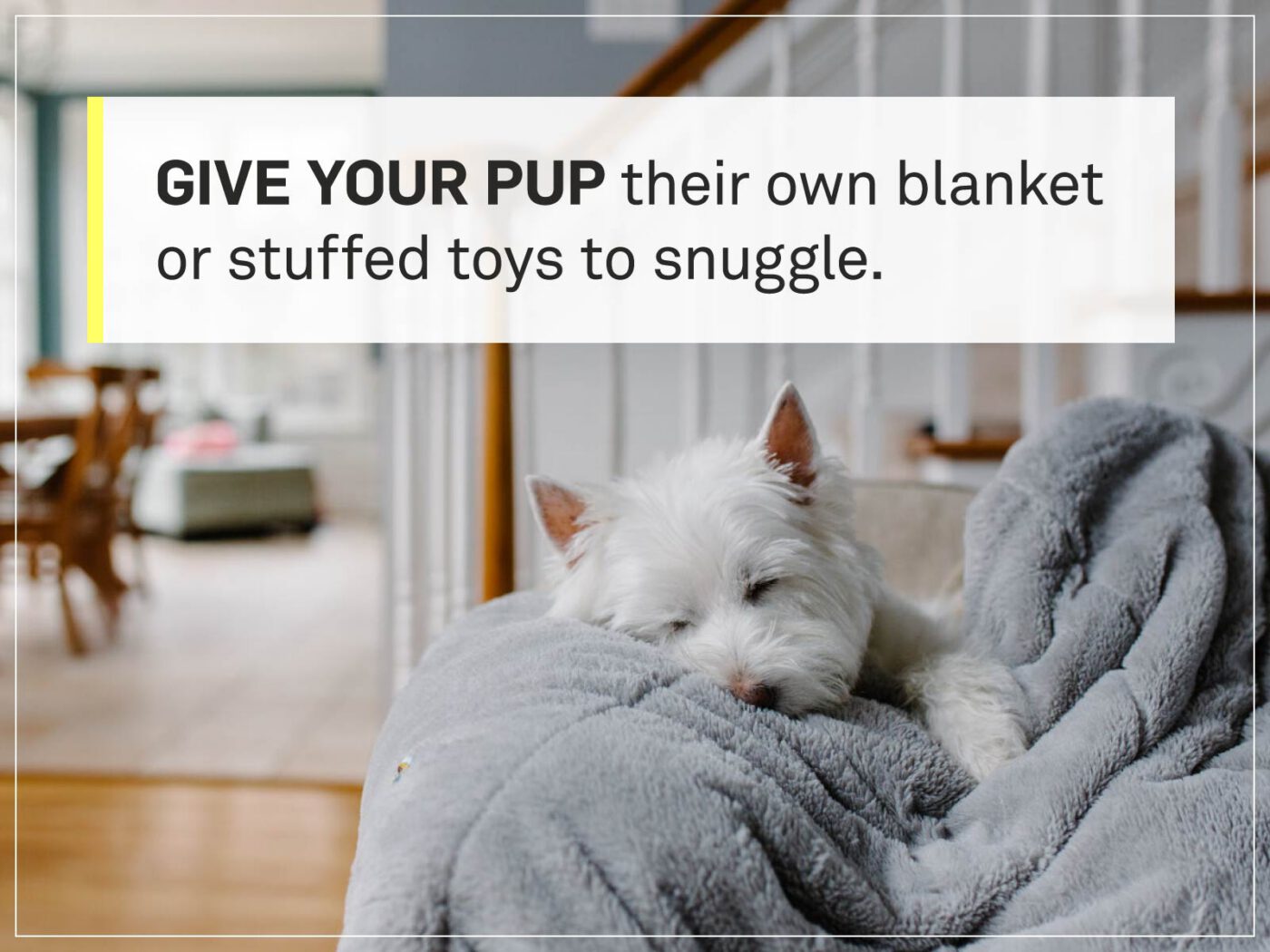
Blankets
The best way to make sure your pup feels safe in their crate or anywhere is to have a few blankets that are theirs. You may choose to put this blanket in their kennel, on their bed or any place they like to snuggle up.
Stuffed Dog Toys
Many puppies like having a stuffed animal “companion.” It’s something soft that they can carry around with them or cuddle with. When choosing a stuffed animal, make sure there are no small parts that can be chewed off and swallowed or choked on (like beaded eyes or decorative elements).
Extra Dog Bed
It can be helpful to have another dog bed on hand either for multiple rooms or in case your puppy has an accident on one. They should always have a soft place to lie down and an extra bed will assure they always do.
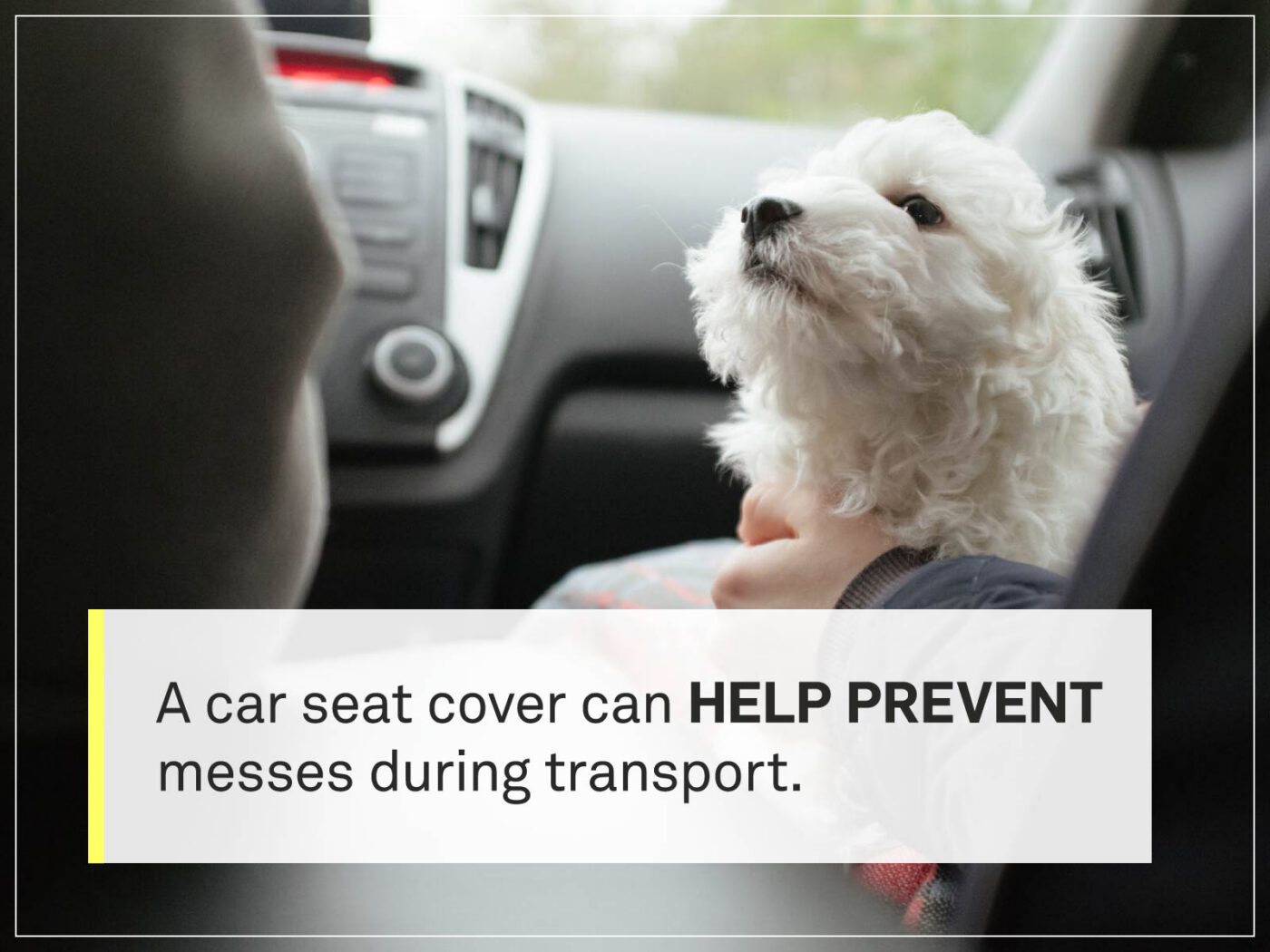
Puppy Toys, Training and Travel
There are all sorts of things you can get your puppy to make sure they’re always entertained. When it comes to training, sometimes these items can overlap. Here are some things you should get your pup that are fun, educational and that will help them get to know the world around them.
Training Treats
Get your puppy some low-calorie training treats so that you can reward them when they have done something right. These are great for potty training, leash training and tricks! You’ll be using these quite a bit the first few months which is why it’s important that the treats are healthy and low-calorie if possible.
Training Clicker
Another popular method of training is to use a clicker. The idea is that you use treats to reward your pup for good behavior, then you use the clicker and a treat. Eventually, you should be able to wean them off treats so that they respond positively to just the clicker.
Chew Toys
If puppies like to do one thing, it’s chew. Especially when they are teething, it’s important to have something in the house that they are allowed to chew on. If you don’t, you may find that they have designated their own chew toy out of one of your possessions!
The best chew toys are quality, durable and safe. You will need to assess your dog’s tendencies (do they destroy their toys, inhale or nibble on them) to determine the best chew toy for them.
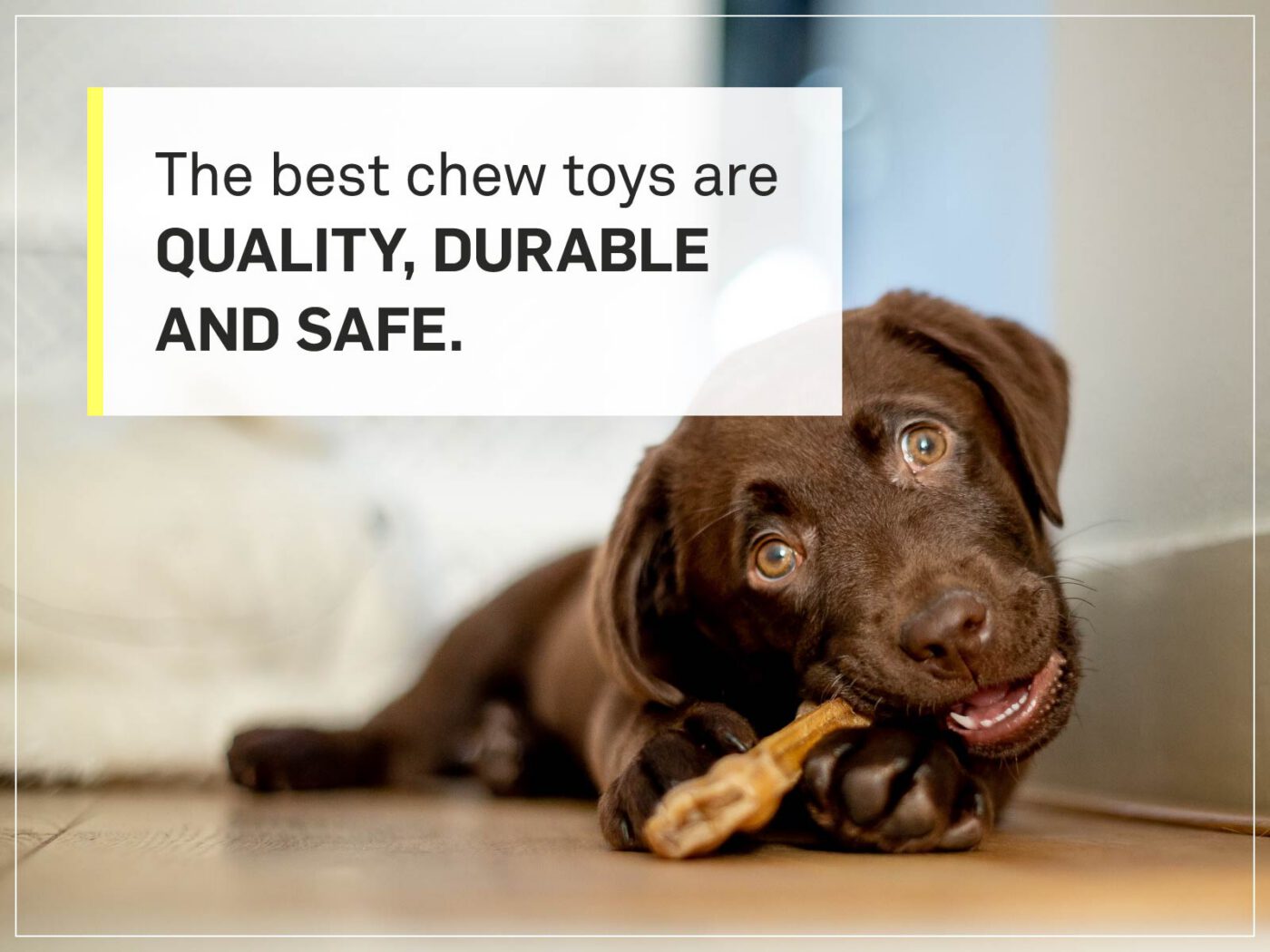
Puzzle Toys/Brain Games
Puppies need to be kept busy when they are not sleeping, so having an interesting puzzle or brain training game around can be helpful. If your dog spends several hours alone, interactive toys are good for them (as long as the toys don’t require supervision). These toys can also help develop your pup’s brain and keep dogs that “need a job” occupied.
Chase Toys
For the pup with a lot of extra energy, chase toys can be incredibly helpful. While they won’t take the place of a daily walk, these toys can be thrown, rolled or moved about so that your dog can expend some energy chasing them.
No-Chew Spray
Even the most well-entertained dogs may chew on the house. This spray, which usually contains something safe but poor-tasting like tea tree oil or lemon, can be sprayed on any cabinets or furniture to deter chewing.
Frozen Toys
While your puppy is teething it can be helpful to have a frozen chew toy around for them to use. Most pet stores sell toys that are meant to be frozen, but you can also freeze a rubber Kong toy or DIY a toy using a towel.
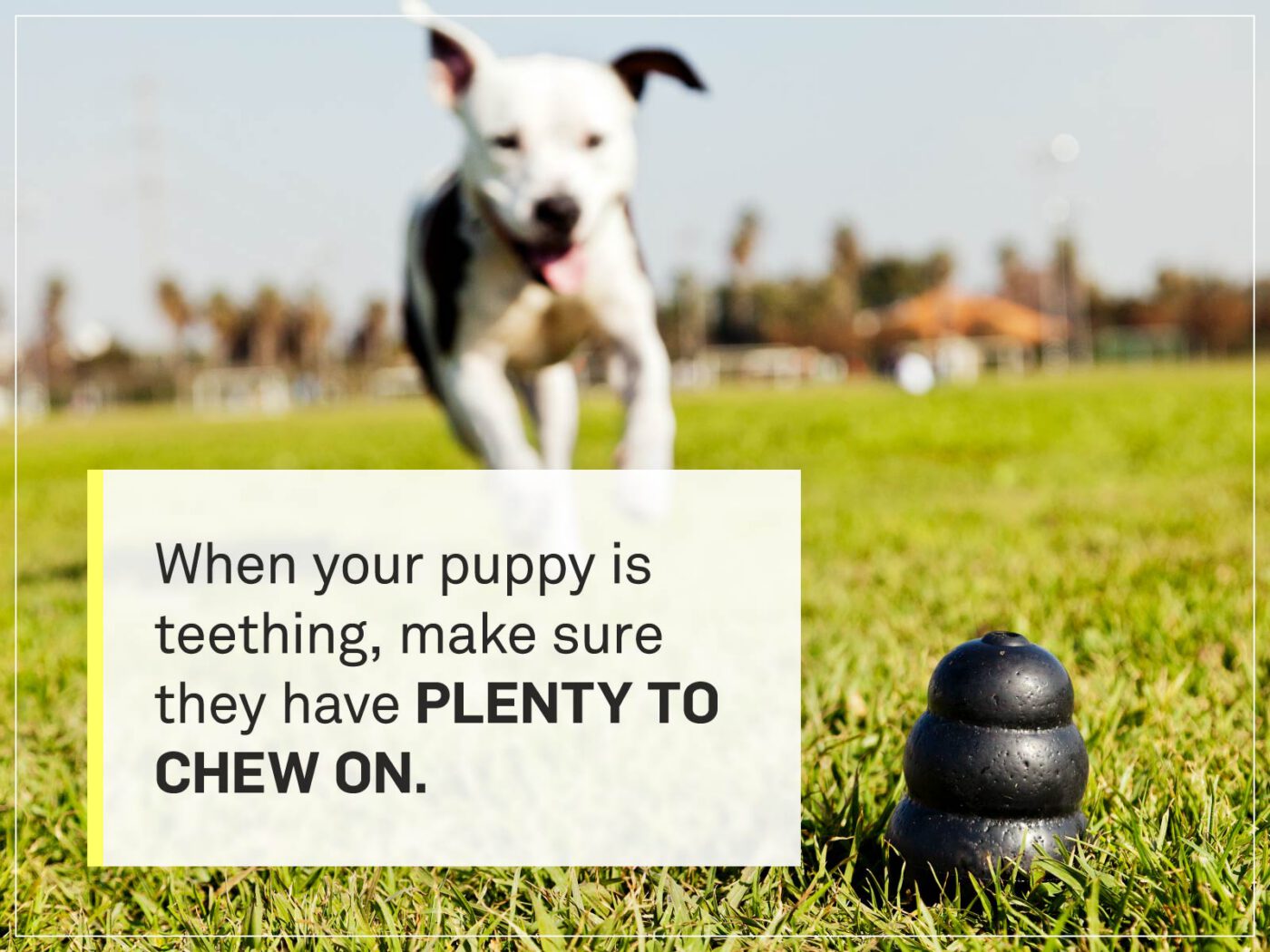
Car Seat Cover
If you plan on transporting your puppy in the car, it’s helpful to get a seat cover so that they don’t shed on the seat. This can also be helpful if the puppy is still potty training or if they tend to get a little dirty at the dog park.
Collapsible Food and Water Bowls
Another great travel accessory is a set of collapsible food and water bowls. If you live in a hot climate it’s important to make sure your puppy has access to water at all times, even if you take them to the dog park or on a nature trail.
Large Travel Crate or Bed
If you’re going to be in the car for several hours or if you travel frequently you might want to think about investing in a large travel bed or crate. These ensure your dog is safe and comfortable anywhere you take them!
Dog Travel Bag
If you get toys and accessories for your pup you will need somewhere to store them. Purchase a dog travel bag to have all their things in one place.
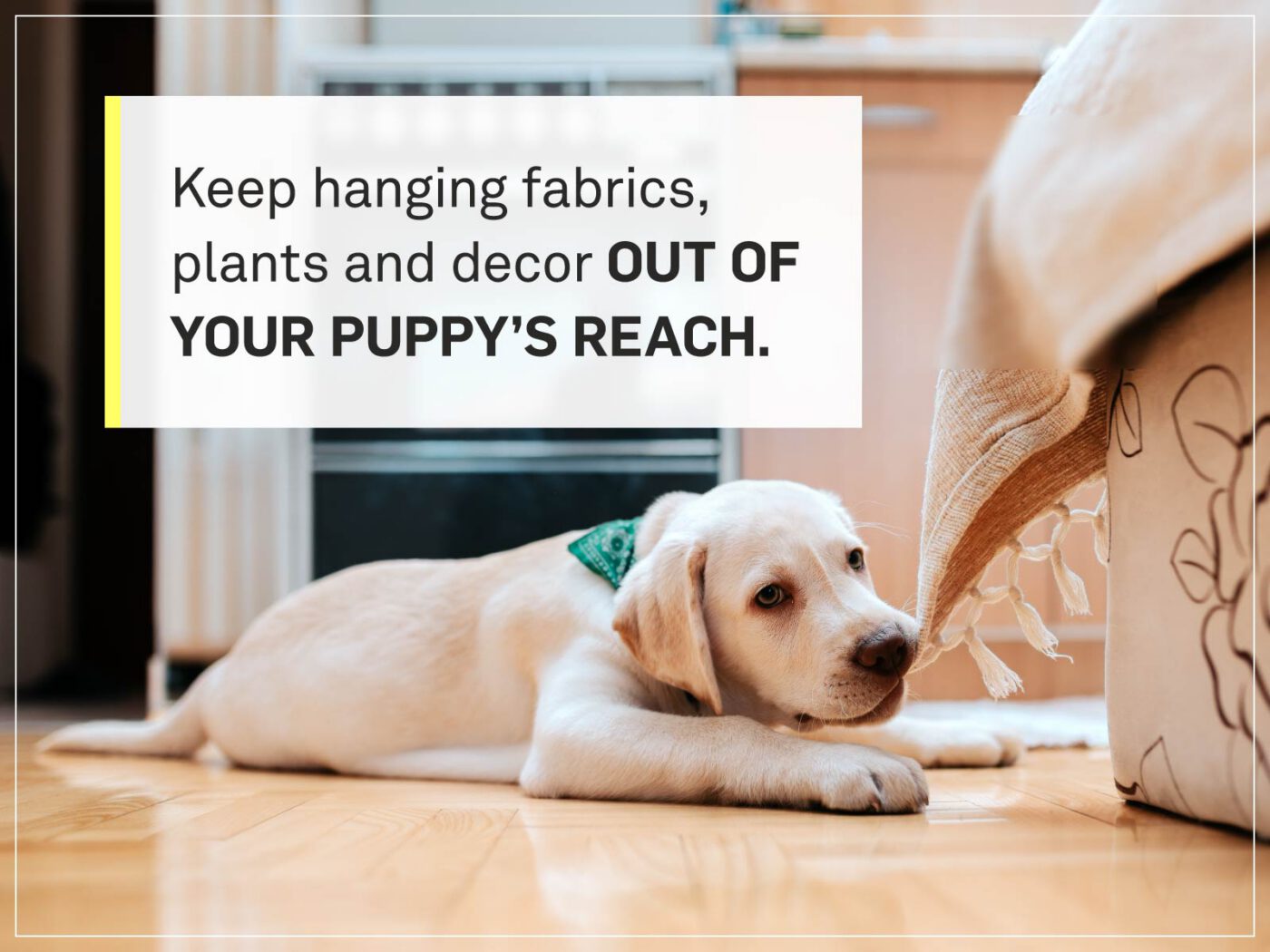
Puppy Proofing
Before your new family member arrives, there are several things you can do to puppy proof your home. Not only can puppy proofing help keep your belongings and home in-tact, but they can help keep your pup safe.
Put Away Floor-Level Plants and Decor
Puppies love to dig in plants and knock over vases. If there is anything that your puppy can knock over or get into on the ground level of your home, we’d advise putting it up (at least temporarily).
Secure Hanging Fabrics
Dogs are naturally curious and puppies are even more so. If there are hanging fabrics like curtains or tablecloths, your pup may try to investigate and pull on them. Not only can this ruin your fabric, but if there is something sitting on top of the fabric it will likely come crashing down. It’s safer to put these away when you bring your new puppy home.
Remove Breakables + Small Objects from Low Surfaces
If there are any small or breakable objects within reach of your puppy you should put them up before letting your puppy run around your house. Just like human babies, puppies can choke on small objects and are likely to put anything they can reach in their mouths.
Secure Wires
You don’t want your puppy chewing on any exposed wires as this can be dangerous for them and ruin your wire. Either hide these behind a surface where your puppy can’t get to them or put them away for the time being.
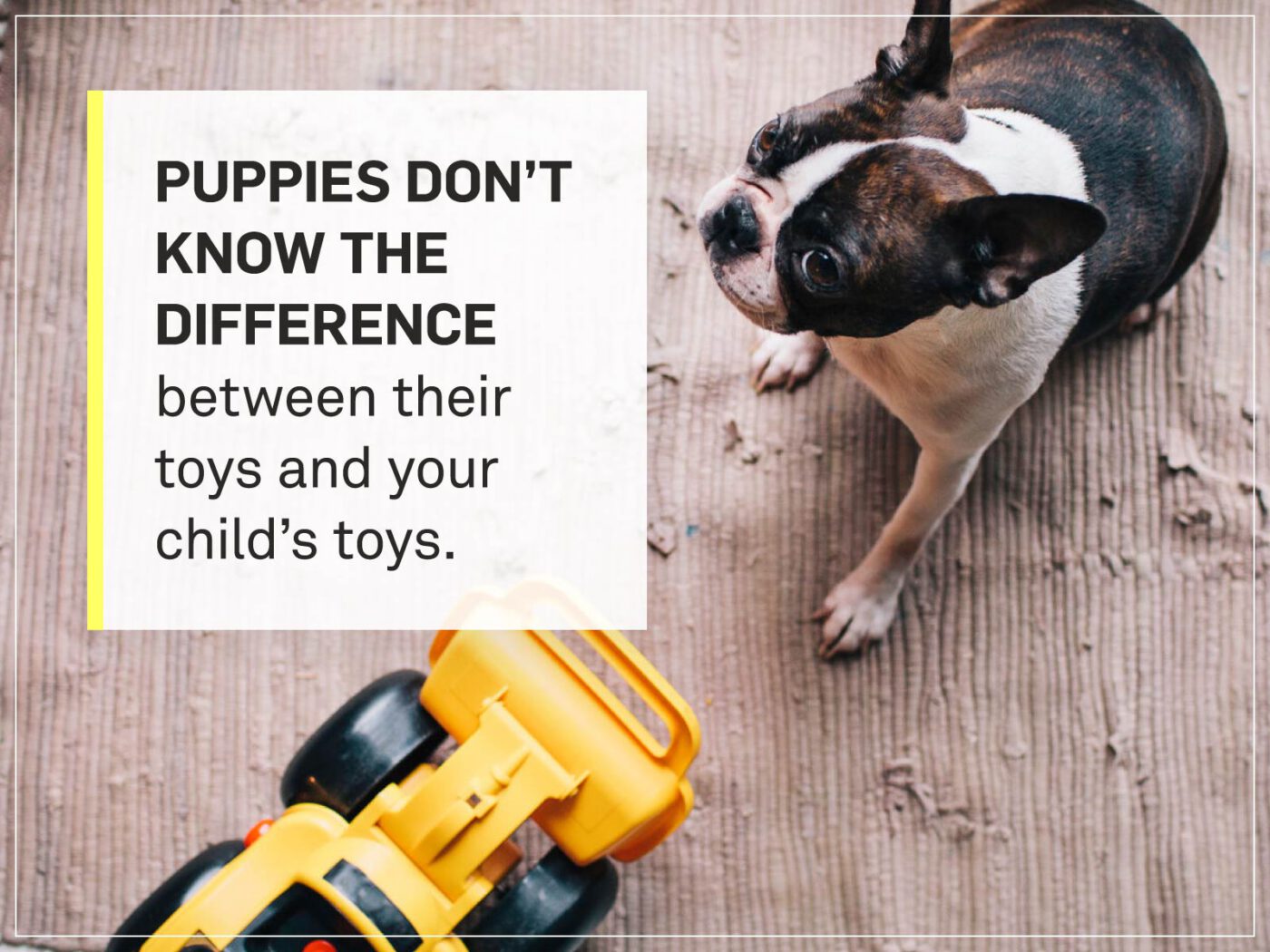
Put Away Children’s Toys or Accessories
Puppies don’t know the difference between their toys and a human child’s toys. If you would like to avoid your pup “playing” with toys that aren’t theirs make sure you put them away and teach your family to do the same.
Clean Up + Secure The Yard
If there are any hoses, tools, toys or other things in your yard, pick them up before allowing your puppy to roam back there. If you have a pool, make sure it’s secured so that your puppy can’t fall in and drown!
Lock Up Cleaners and Chemicals
It can be very dangerous for your puppy if they chew into a piece of plastic that contains chemicals or cleaners. Make sure all house cleaning supplies, yard chemicals, pool chemicals and any other toxic fluids are secured and out of reach.
Clear Your Schedule
In order to adjust properly, your puppy will need your attention and supervision —especially the first week that you bring them home. Make sure you have enough time in your schedule to help your puppy grow accustomed to you and your home.
Be sure you have set aside enough time to allow them outside every two to three hours. You will also want to spend time bonding with them, training them and socializing them. It’s a huge commitment, but in return, your pup will give you a lifetime of love and companionship.
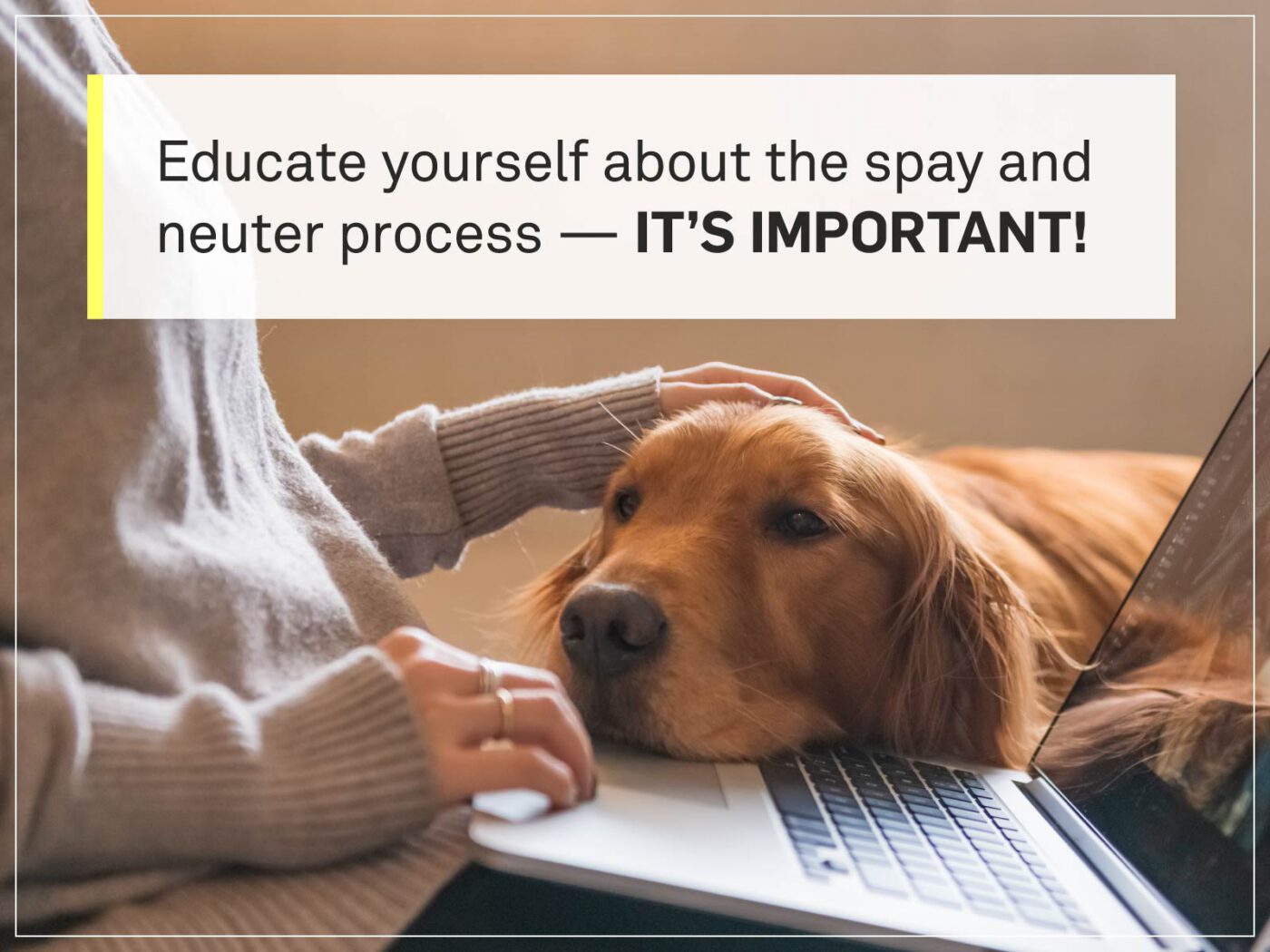
More Puppy Resources
If you’d like more in-depth information on how to raise, train and care for your new puppy, check out the resources below. Be sure to educate yourself about the spay and neuter process, as this is an important part of pet parenting.
- Petsmart Spay and Neuter Clinic Database: Helps you find spay and neuter clinics in your area.
- How to House Train Your Dog: Information from the Humane Society on how to potty train your new furry friend.
- How to Care for a New Puppy: A guide that covers everything from how to introduce your new puppy to your home to what to feed and what not to feed a puppy.
- How to Find a Veterinarian: Tips from the American Vet Association on how to find the right vet for your new puppy.
- How to Clean Up Accidents: This guide goes over the safest way to pick up your pup’s pee and poo after an accident.
- How to Prevent Your Puppy from Chewing: Expert tips to prevent your pup from gnawing on your belongings.
- How to Bathe Your Puppy: Dog expert, Cesar Milan, talks about the best way to bathe and groom your new pup.
- Ultimate Puppy: Information on everything from potty training to socialization, games and more!
- Online Dog Training: Can be affordable and convenient way to train your pup at home.
Getting a new puppy is a challenging, but rewarding experience. If you take the time and effort to raise your puppy correctly, you will be repaid by the endless love and affection of a “good dog.” We hope this list has been helpful — feel free to use the printable version below!
As you’re considering the health and wellness of your puppy, consider banking your pups stem cells so that they can be used at a later date. The healing power of stem cells can help your dog should they ever need it down the line!
